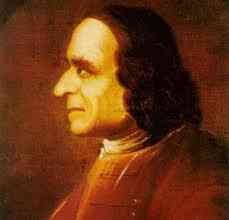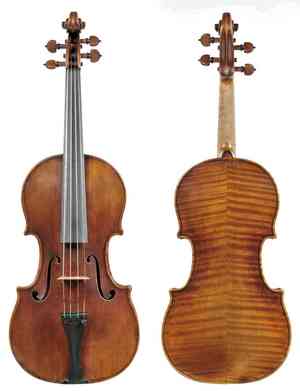


Giuseppe Tartini
Source: Mythologia
Born in Piran which is in the Republic of Venice (present-day Slovenia) on 6 April 1692, Giuseppe Tartini bridges the baroque to classical periods. He received his elemental education, including music, from Franciscans. While later studying law at the University of Padua, Tartini pursued the martial art of fencing. In 1710 he married trouble in Elisabetta Premazone. As she was the mistress of Cardinal Giorgio Cornaro, Tartini faced charges of abduction, from which he fled to the Franciscan monastery in Assisi. He there began to study the violin. Though scholars believe it to be of a later date, Tartini has written of composing his famous Sonata in G Minor, 'Il Trillo del Diavolo', as early as 1713. He became the first known owner of a violin made by Antonio Stradivari in 1715:

Stradivarius owned by Tartini
Source: A Violin's Life
In 1716 Tartini went to Ancona to work in that city's opera orchestra. He moved up to Maestro di Cappella at the Basilica di Sant'Antonio in Padua in 1721. As it was about that time, 1720, that catalogues of Tartini have him beginning to compose his first works, it is well to comment that the major catalogues of Tartini are necessarily thematic due that dates are difficult to identify. IMSLP refers to four catalogues. The first published was 'Die Violinkonzerte Giuseppe Tartinis' in Berlin in 1935 by Minos Dounias to which "D" numbers refer. As the title implies, it addresses violin concertos only. In 1935 Antonio Capri published 'Giuseppe Tartini' in Milan to which "C" numbers refer. "B' numbers are assigned to violin sonatas per Paul Brainard's 'Die Violinsonaten Giuseppe Tartinis' of 1959 published in Göttingen. The catalogue most specifiedd at IMSLP is 'Catalogo tematico delle composizioni di Giuseppe Tartini' published in 2020 by Guido Viverit, Alba Luksich and Simone Olivari. That employs the works of Dounias and Brainard, thus is the more inclusive. That catalogue uses "GT" or "G" identifiers followed by numbers 1 through 6 which designate categories: 1 concertos for solo, 2 sonatas for solo, 3 duets, 4 sonatas a tre, 5 sonatas a quatro and 6 vocal works. Data below is drawn from the GT catalogues at Discover Tartini and L'Orchestra Virtuale del Flaminio where B and D designations can be matched [refs below]. Regardless of when Tartini wrote his early works, none were likely published before 1730.
'Violin Concerto in D major' Giuseppe Tartini Movement 1 of 3: Allegro
GT 1.D03 D 17 Composed sometime 1720-1730
Orfeo Orchestra conducted by György Vashegyi Violin: László Paulik Sometime <1996
'Violin Concerto in A major' Giuseppe Tartini Movement 1 of 3: Allegro
GT 1.A01 D 88 Composed sometime 1720-1730 Published in Amsterdam c 1930
L'Arte dell'Arco conducted by Giovanni Guglielmo Violin: Federico Guglielmo Sometime <2004
Tartini opened a music school in Padua 1726. Limiting himself to only several exclusive students at a time allowed him to gradually develop a systematic approach to music throughout the years by which he would make his name as a music theorist. In the meantime he continued composing works for violin. Pieces below are with basso continuo. 'The Devil's Trill' is probably his most famous composition:
'Sonata for violin and bass in G minor' ('Didone abbandonata') Giuseppe Tartini
GT 2.G10 3 Movements Composed c 1731 Published Amsterdam 1734
Violin: Federico Guglielmo Harpsichord: Roberto Loreggian
'Sonata for violin and bass in G minor' ('Le trille du diable') Giuseppe Tartini
GT 2.G05 3 Movements Composed 1740-49 Published 1798
Orchestre D'Auvergne conducted by Jean-Jacques Kantorow
Violin: Jean-Jacques Kantorow Sometime <1994
Tartini's fame today is principally as a music theorist, more specifically for what are called "Tartini's Tones" or, combination tones that are the creation of a third tone by the simultaneous production of two other tones. He thusly examined acoustics and temperament in a treatise published in 1754 titled 'Trattato di musica secondo la vera scienza dell'armonia'. Albeit Georg Andreas Sorge published the same discovery in 1745-47 in his 3-volume 'Vorgemach Der Musicalischen Composition', Tartini comments that he learned of combination tones as early as 1714. Howsoever, moving into Tartini's latter career, he is thought to have composed his 'Stabat Mater in F Major' in 1769 shortly before his death, that published in 'Secunda Anthologia Vocalis', a work by Oreste Ravanello printed by Marcello Capra in 1903.
'Stabat Mater for Three Voices' Giuseppe Tartini
GT 6.4.F01 Composed possibly 1769 Published 1903 Recording unidentified
Tartini died in Padua on 26 February 1770, the year of Beethoven's birth later in Dcember. Tartini authored some 160 concertos for various string or flute, and about 190 sonatas for strings, nigh the whole of his oeuvre featuring violin. Other close contemporaries of Tartini notable in music theory include JS Bach, Rameau and the much younger Marpurg.
Sources & References for Giuseppe Tartini:
Encyclopedia Britannica (1911 alt)
Audio:
Catalogues: Catalogo tematico delle composizioni di Giuseppe Tartini (The GT 2020):
L'Orchestra Virtuale del Flaminio
Combination Tones (Tartini Tones):
The Devil’s Trill: analyses: Christiano da Cruz Ribeiro e Rodrigues Wikipedia
Stabat Mater: analysis: Stabat Mater
Marriage to Elisabetta Premazone v Cardinal Giorgio Cornaro: Interlude
Publications by Giuseppe Tartini:
Trattato di musica secondo la vera scienza dell'armonia (1754):
Recordings of Giuseppe Tartini:
DAHR (1910-1935)
Scores: Internet Archive Stabat Mater
Further Reading:
Combination Tones (Tartini Tones):
Poetical Mottos in Tartini’s Concertos: Piotr Wilk (Jagiellonian University Cracow)
Secunda Anthologia Vocalis (Oreste Ravanello / Capra 1903):
Stradivarius (violin brand of Antonio Stradivari c 1644-1737):
Wikipedia (string instruments made by Stradivarius)
Giuseppe Tartini:
Bibliography:
Bruno Ravnikar (combination tones)
Classical Main Menu Modern Recording
|
|
hmrproject (at) aol (dot) com